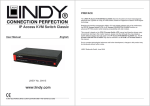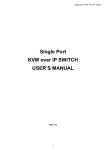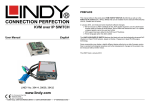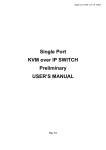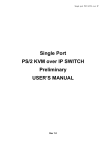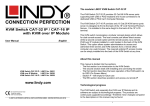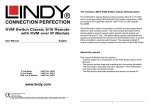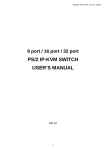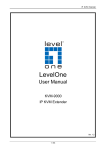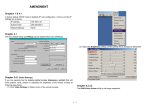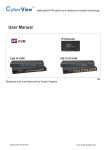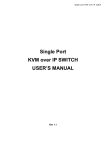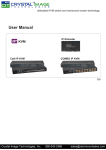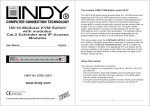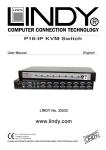Download 2.2 Connections
Transcript
CPU IP Access Switch Lite User Manual English LINDY No. 39405 www.lindy.com © LINDY ELECTRONICS LIMITED & LINDY-ELEKTRONIK GMBH - FIRST EDITION (April 2005) Contents 1. INTRODUCTION ..................................................................................................................... 1 1.1 Features ................................................................................................................................ 2 1.2 Package Contents ................................................................................................................ 2 1.3 Technical Specifications ..................................................................................................... 3 1.4 System Requirements ......................................................................................................... 3 2. HARDWARE INSTALLATION ................................................................................................ 4 2.1 Operation Overview ............................................................................................................. 4 2.2 Connections ......................................................................................................................... 5 2.2.1 Host Connection Side...................................................................................................... 5 2.2.2 Console Connection Side ................................................................................................ 5 2.2.3 Network Connection ........................................................................................................ 6 2.2.4 Connecting the IP ACCESS SWITCH LITE to a KVM switch .......................................... 6 2.2.5 Connecting an External Power Switch option .................................................................. 6 3. CONFIGURATION................................................................................................................... 7 3.1 Initial Configuration via a DHCP Server ............................................................................. 7 3.2 Initial Configuration via a Serial Console .......................................................................... 7 3.3 IP ACCESS SWITCH LITE Setup Tool ................................................................................ 8 3.3.1 MAC Address Detection .................................................................................................. 8 3.3.2 Authentication.................................................................................................................. 9 3.3.3 IP Auto Configuration ...................................................................................................... 9 3.4 Keyboard, Mouse and Video configuration ..................................................................... 10 3.4.1 IP ACCESS SWITCH LITE Keyboard Settings ............................................................. 10 3.4.2 Remote Mouse Settings ................................................................................................ 10 3.4.3 Host System Mouse Settings ........................................................................................ 11 3.4.4 Single and Double Mouse Mode.................................................................................... 11 3.4.5 Recommended Mouse Settings..................................................................................... 12 3.4.6 Video Modes ................................................................................................................. 12 4. USAGE .................................................................................................................................. 13 4.1 Prerequisites ...................................................................................................................... 13 4.2 Logging In........................................................................................................................... 14 4.2.1 Login to the IP ACCESS SWITCH LITE ........................................................................ 14 4.3 Navigation........................................................................................................................... 15 4.3.1 Remote Console Main Window ..................................................................................... 16 4.3.2 Remote Console Control Bar......................................................................................... 17 4.3.3 Remote Console Status Line ......................................................................................... 21 5. MENU OPTIONS ................................................................................................................... 22 5.1 Remote Control .................................................................................................................. 22 5.1.1 KVM Console................................................................................................................. 22 5.1.2 Telnet Console .............................................................................................................. 23 5.2 Virtual Media....................................................................................................................... 25 5.2.1 Floppy Disk.................................................................................................................... 25 5.2.2 Create a CD-ROM/ISO Image ....................................................................................... 27 5.2.3 Drive Redirection ........................................................................................................... 30 5.2.4 Options .......................................................................................................................... 32 5.3 User Management .............................................................................................................. 33 5.3.1 Change Password ......................................................................................................... 33 5.3.2 Users & Groups ............................................................................................................. 33 5.4 KVM Settings ...................................................................................................................... 35 5.4.1 User Console................................................................................................................. 35 5.4.2 Keyboard/Mouse ........................................................................................................... 38 5.4.3 Video ............................................................................................................................. 39 5.5 Device Settings .................................................................................................................. 40 5.5.1 Network ......................................................................................................................... 40 5.5.2 Dynamic DNS ................................................................................................................ 42 5.5.3 Security ......................................................................................................................... 44 5.5.4 Certificate ...................................................................................................................... 45 5.5.5 Serial Port...................................................................................................................... 48 5.5.6 Date And Time............................................................................................................... 50 5.6 Maintenance ....................................................................................................................... 53 5.6.1 Device Information......................................................................................................... 53 5.6.2 Event Log ...................................................................................................................... 54 5.6.3 Update Firmware ........................................................................................................... 54 5.6.4 Unit Reset...................................................................................................................... 56 6. TROUBLESHOOTING........................................................................................................... 57 7. KEY CODES.......................................................................................................................... 59 8. VIDEO MODES...................................................................................................................... 61 9. RACK MOUNT KIT INSTALLATION..................................................................................... 62 10. RADIO FREQUENCY ENERGY, CERTIFICATIONS .......................................................... 63 1. Introduction Thank you for purchasing the LINDY CPU IP ACCESS SWITCH LITE. This device allows operators to monitor and access their computers from remote locations. The IP ACCESS SWITCH LITE connects to the internet, intranet, LAN or WAN using standard CAT5 or higher cable, then uses a KVM cable to connect a local KVM switch or server. The IP ACCESS SWITCH LITE combines convenient digital remote KVM access and control with integrated system management. It captures, digitizes and compresses the video signal and transmits it alongside the keyboard and mouse signals, to and from a remote computer. The IP ACCESS SWITCH LITE provides a non-intrusive solution for remote access and control. Remote access and control software runs on its embedded processors only – so there is no interference with server operation, or impact on network performance. The IP ACCESS SWITCH LITE supports PS/2 keyboard/mouse and 15-way VGA type monitor connections. It automatically detects the video mode of the console and allows manual fine tuning for improved video quality. The IP ACCESS SWITCH LITE also features remote mass storage support – the unit connects via a USB connection to the computer and allows virtual storage devices to be setup on the host and accessed from the client. 1 1.1 Features Remote access of KVM switches or servers via LAN, WAN, or the internet; control your installation from almost anywhere in the world KVM (keyboard, video, mouse) access over IP and analogue telephone line (requires modem) BIOS level access SSL encryption No impact on server or network performance Automatically senses video resolution for best possible screen capture High-performance mouse tracking and synchronisation User console port for direct access to KVM switch Local mouse suppression (only when using SUN’s Java Virtual Machine) Can be used with any standard PS/2 Keyboard/Mouse & VGA Monitor Remote mass storage control Compatible with Windows 98SE/ME/2000/XP & 2003 Server, Mac OS 10 and Linux Red Hat/Fedora/Knoppix 1.2 Package Contents CPU IP ACCESS SWITCH LITE Power Adapter Rack mount kit RS-232 Serial cable, 1.8m USB 2.0 A to B type Cable, 1m (for remote mass storage use ) 3-in-1 KVM Cable, 1m (for PC/KVM) Software CD This manual 2 1.3 Technical Specifications Item Description PC Port Connectors PS/2 Keyboard Mini Din 6 Pin Female PS/2 Mouse Mini Din 6 Pin Female VGA HDDB 15 Pin Female USB Type B Female Console Port Connector (All Female Types) Local Console: PS/2 Keyboard Mini Din 6 pin PS/2 Mouse Mini Din 6 pin VGA HDDB 15pin Remote Console: RJ-45 8P8C Serial Port (DB9 pin Male) RS-232 DB9 Pin Male LAN port (RJ-45 8P8C) 10BASE-T Ethernet uses Category 3/4/5/5E/6 UTP; 100BASE-T Ethernet uses Category 5/5E/6 UTP Keyboard Emulation PS/2 Mouse Emulation PS/2 VGA Resolution Local :1600 x 1200; Remote : 1280 x 1024 Housing Metal Power Adapter Operation Temperature Storage Temperature 5V DC, 2.5A 0~50° -20 ~ 60° Humidity 0~80%, Non-Condensing Weight (kg) 1700g Dimension (WxDxH) 139 x 156 x 27mm 1.4 System Requirements Item Description Local console side One PS/2 Keyboard, one PS/2 Mouse, one VGA monitor Remote Console side One PC or multiple PCs linked to the network Computer side One PC/ Server or the console port of a KVM switch 3 2. Hardware Installation 2.1 Operation Overview The pictures below show the connection options of the IP ACCESS SWITCH LITE. The IP ACCESS SWITCH LITE redirects local keyboard, mouse, and video signals to a remote administration console. All data is transmitted using the TCP/IP protocol. Server (Host) IP Access Switch Lite IP Network Administrator (Client) Controlling a single computer The IP ACCESS SWITCH LITE can be used in a multi administrator and multi server environment as well. Attaching one or more IP ACCESS SWITCH LITE units to a KVM switch matrix allows multiple server access via a single remote console. IP Network KVM Switch IP Access Switch Lite Administrator (Client) Controlling multiple computers via a KVM Switch 4 2.2 Connections 2.2.1 Host Connection Side Use the supplied 3-in-1 combined KVM cable and USB cable to make the connections to the host computer. The DC power supply connection is also made here. Mouse port connection Keyboard port connection VGA port connection Reset switch USB port connection DC power supply socket 1. Plug the power adapter into the mains and connect the jack to the DC power supply socket 2. Connect the VGA port connection to the VGA port on the host computer 3. Connect the keyboard and mouse port connections to the PS/2 keyboard and mouse ports on the host computer 4. (Optional) If you want to use the remote mass storage control feature, use the supplied USB A-B cable to connect the USB port on the IP ACCESS SWITCH LITE to a USB port on the host system 2.2.2 Console Connection Side Connect your local keyboard, monitor and mouse console here. The Ethernet network connection and serial port connection is also made at this side of the IP ACCESS SWITCH LITE. PS/2 keyboard connection RS-232 serial port connection RJ-45 Ethernet connection VGA monitor connection PS/2 mouse connection 1. Connect a VGA monitor to the VGA monitor connection on the IP ACCESS SWITCH LITE 2. Connect your PS/2 keyboard and mouse to the PS/2 connection ports 3. (Optional) Connect a modem or RS-232 terminal to the RS-232 serial port connection 4. Connect an Ethernet cable to the RJ-45 Ethernet port. 5 2.2.3 Network Connection The IP ACCESS SWITCH LITE provides an RJ-45 port for an Ethernet connection. The port can be used with a 100Mbps, 100Base-TX connection or a 10Mbps, 10Base-T connection. The IP ACCESS SWITCH LITE will sense the connection speed and automatically adjust to the appropriate operation mode. 10Mbps Connection For 10Base-T Ethernet networks, the Ethernet adapter should use Category 3, 4, 5 or 6 UTP cable. To establish a 10Mbps connection, the cable must be connected to a 10Base-T hub. 100Mbps Connection For 100Base-TX Fast Ethernet networks, the IP ACCESS SWITCH LITE supports Category 5 or 6 UTP cabling. To establish a 100Mbps connection the cable must be connected to a 100BaseTX hub. 2.2.4 Connecting the IP ACCESS SWITCH LITE to a KVM switch To connect the IP ACCESS SWITCH LITE to your KVM switch, use a 3-in-1 combined KVM cable and connect the video, keyboard and monitor ports on the host side of the KVM switch to the Local Console port on the KVM switch. See diagram below: IP ACCESS SWITCH Host Side 8 Port KVM switch 2.2.5 Connecting an External Power Switch option At the time of writing (April 2005) the IP ACCESS SWITCH LITE supports the following external power switch options. Please refer to the individual manufacturers manuals for advice on connecting to the IP ACCESS SWITCH LITE. Avocent SPC1 800/1600 Sentry In-Line Power Module Leaning ePowerSwitch Peppercon IPM-220L 6 3. Configuration The CPU IP ACCESS SWITCH LITE’s Parameter communication interfaces are all based on IP auto configuration TCP/IP. The switch comes pre-configured IP-Address with the IP configuration detailed here: Net-mask Default-Gateway Value DHCP 255.255.255.0 none Note: If the DHCP connection fails on boot-up, the IP ACCESS SWITCH LITE will not have an IP address. If this initial configuration does not meet your requirements, the following section describes the configuration that is necessary to access the IP ACCESS SWITCH LITE for the first time. 3.1 Initial Configuration via a DHCP Server By default, the IP ACCESS SWITCH LITE will try to contact a DHCP server in the subnet to which it is physically connected. If a DHCP server is found, it will provide a valid IP address, gateway address and net mask. Before you connect the device to your local subnet, be sure to complete the corresponding configuration of your DHCP server. It is recommended to configure a fixed IP assignment to the MAC address of the IP ACCESS SWITCH LITE. You can find the MAC address labelled on the bottom of the switch. Use the setup tool to adjust the values to your needs. The setup tool can be found on the supplied CD ROM. Follow the procedure described on the next page (Section 3.3) 3.2 Initial Configuration via a Serial Console The IP ACCESS SWITCH LITE has a serial line interface (host side) for connecting a serial terminal. This connector is compliant with the RS-232 serial line standard. The serial line has to be configured with the parameters given in this table: Parameter Bits/second Data bits Parity Stop bits Flow Control Value 115200 8 No 1 None When configuring with a serial terminal, reset the IP ACCESS SWITCH LITE and immediately press the ESC key. You will see some device information and a “=>” prompt. Type config and press the Enter key. Wait a few seconds for the configuration questions to appear. As you proceed, the following questions will appear on the screen. To accept the default values (shown in square brackets below) press the Enter key. IP auto configuration (non/dhcp/bootp) [dhcp]: IP [192.168.1.22]: Net mask [255.255.255.0]: Gateway (0.0.0.0 for none) [0.0.0.0]: 7 3.3 IP ACCESS SWITCH LITE Setup Tool 3.3.1 MAC Address Detection Connect the IP ACCESS SWITCH LITE to your computer either via a local network, or via USB. If you use a USB connection Windows will detect the IP ACCESS SWITCH LITE as a ‘Removable Disk’ and an appropriate drive letter will be assigned. Start the setup tool from the CD ROM. A window opens as shown below: On the upper left corner, the MAC address of the IP ACCESS SWITCH LITE is displayed. To detect the MAC address, press the Refresh Devices button. The displayed MAC address is the same as that printed on the sticker on the base of the unit. On the lower right corner of the window, there are two buttons: Query Device and Setup Device. Press the Query Device button to display the preconfigured values of the network configuration. The values are displayed in the text fields located above. If necessary, adjust the network settings to your needs. To save the changes enter a user login and a password (see 3.3.2 Authentication, on page 9) and then press the Setup Device button. 8 3.3.2 Authentication To adjust the authentication settings, enter your login as a super user and change your password. Super user login Enter the login name of the super user. The initial value is super. All of the characters are lower case. Super user password Enter the current password for the super user. This initial value is pass. All of the characters are lower case. New super user password Enter the new password for the super user. New password (confirm) Re-type the new password for the super user. To close the window and accept the changes, press the OK button, otherwise press the Cancel button. 3.3.3 IP Auto Configuration With this option, you can specify whether the IP ACCESS SWITCH LITE should obtain its network settings from a DHCP or BOOTP server. From the drop down list select either DHCP or BOOTP. If you select NONE, the IP auto configuration is disabled and you should manually input the following network settings: IP address The IP address the IP ACCESS SWITCH LITE uses. Net mask The net mask of the connected IP subnet. Gateway address The IP address of the default router for the connected IP subnet. If you do not have a default router, enter 0.0.0.0. 9 3.4 Keyboard, Mouse and Video configuration Between the IP ACCESS SWITCH LITE and the host, there are two interfaces available for transmitting keyboard and mouse data: USB and PS/2. The correct operation of the remote mouse depends on several settings which will be discussed in the following subsections. 3.4.1 IP ACCESS SWITCH LITE Keyboard Settings The IP ACCESS SWITCH LITE settings for the host's keyboard type have to be correct in order to make the remote keyboard work properly. The settings can be checked using the IP ACCESS SWITCH LITE front-end. 3.4.2 Remote Mouse Settings A common problem with KVM devices is the synchronization between the local and remote mouse cursors. The IP ACCESS SWITCH LITE addresses this problem with an intelligent synchronization algorithm. There are two mouse modes available on the IP ACCESS SWITCH LITE: Auto mouse speed and Fixed mouse speed. Auto mouse speed The automatic mouse speed mode tries to detect the speed and acceleration settings of the host system automatically. Speed detection is performed during mouse synchronization. If the mouse does not move correctly, there are two ways to re-synchronize the local and remote mouse: Fast Sync: Fast synchronization is used to correct a temporary, but fixed skew. Choose this option using the Remote Console options menu or by pressing the mouse synchronization hotkey sequence - [ALT] + [F12] Intelligent Sync: If the fast sync does not work correctly or the mouse settings have been changed on the host system, you can use the intelligent resynchronization option. This method can be accessed from the Mouse Handling sub menu of the Remote Console Option menu. Intelligent synchronization requires a correctly adjusted picture. Use the auto adjustment function or manual correction in the Video Settings panel to setup the picture. The Sync mouse button on top of the Remote Console can behave differently, depending on the current state of mouse synchronization. Usually pressing this button leads to a fast sync, except in situations where the KVM port or the video mode was recently changed. Tip: When first started, if the local mouse pointer is not synchronized with the remote mouse pointer, click the Auto Adjust Button once. If the mouse is still not synchronized select Intelligent Sync from the Mouse Handling sub menu of the Remote Console Option menu. Fixed mouse speed This mode just translates the mouse movements from the Remote Console in a way that one pixel move will lead to ‘n’ pixel moves on the remote system. This parameter ‘n’ is adjustable. However, it should be noted that this works only when mouse acceleration is turned off on the remote system. 10 3.4.3 Host System Mouse Settings The host's operating system obtains various settings from the mouse driver. Note: The following limitations do not apply when using USB mice and Windows 2000 and higher! Special Mouse Driver There are mouse drivers which influence the synchronization process and lead to desynchronized mouse pointers. If this happens, make sure you do not use a special vendorspecific mouse driver on your host system. Windows XP Mouse Settings If using Windows XP, disable the enhance pointer precision setting. Active Desktop If the Active Desktop feature of Microsoft Windows is enabled, do not use a plain background. Instead, use some kind of wallpaper. Alternatively, you could also disable the Active Desktop completely. Navigate your mouse pointer into the upper left corner of the applet screen and move it back and forth slightly. In this way the mouse will be resynchronized. If re-synchronizing fails, disable mouse acceleration and repeat the procedure. 3.4.4 Single and Double Mouse Mode The information above applies to Double Mouse Mode, where both remote and local mouse pointers are visible and need to be synchronized. The IP ACCESS SWITCH LITE also features another mode - Single Mouse Mode, where only the remote mouse pointer is visible. Activate this mode in the open Remote Console and click into the window area. The local mouse pointer will be hidden and the remote one can be controlled directly. To leave this mode, use the hotkey combination [ALT] + [F12] to free the captured local mouse pointer. 11 3.4.5 Recommended Mouse Settings For the different operating systems we can give the following advice... MS Windows 2000/2003 (Professional and Server), XP In general, we recommend the use of a USB mouse. Choose USB without Mouse Sync. For a PS/2 mouse choose Auto Mouse Speed. For XP disable the option called enhance pointer precision in the Control Panel. SUN Solaris Adjust the mouse settings either via xset m 1 or use the CDE Control Panel to set the mouse to 1:1, no acceleration. As an alternative you may also use the Single Mouse Mode. MAC OS X We recommend using the Single Mouse Mode. 3.4.6 Video Modes The IP ACCESS SWITCH LITE switch recognizes a limited number of common video modes. When running X11 on the host system, please do not use any custom mode lines with special video modes. If you do, the IP ACCESS SWITCH LITE switch may not be able to detect them. We recommend using any of the standard VESA video modes instead. 12 4. Usage 4.1 Prerequisites The IP ACCESS SWITCH LITE features an embedded operating system offering a variety of standardized interfaces. This section will describe these interfaces, and the way to use them in a more detailed manner. The interfaces are accessed using the TCP/IP protocol family. The following interfaces are supported: Telnet A standard Telnet client can be used to access an arbitrary device connected to the IP ACCESS SWITCH LITE’s serial port via a terminal. HTTP/HTTPS Full access is provided by the embedded web server. The IP ACCESS SWITCH LITE switch environment can be entirely managed using a standard web browser. You can access the IP ACCESS SWITCH LITE using the insecure HTTP protocol, or using the encrypted HTTPS protocol. Whenever possible, use HTTPS. The primary interface of the IP ACCESS SWITCH LITE is the HTTP interface. This is covered extensively in this section. Other interfaces are addressed in the relevant subsections. In order to use the Remote Console window of your managed host system, the browser must feature Java Runtime Environment version 1.1 or higher support. If the browser has no Java support (such as on a small handheld device), you can still maintain your remote host system using the administration forms displayed by the browser itself. Important: We recommend you install the latest version of Sun’s Java Virtual Machine which can be downloaded from the following web site: www.java.com For a non-secure connection to the IP ACCESS SWITCH LITE, we recommend the following browsers: Microsoft Internet Explorer version 6.0 or higher Netscape Navigator 7.0 or Mozilla 1.6 In order to access the remote host system using a securely encrypted connection, you need a browser that supports the HTTPS protocol. Strong security is only assured by using a key length of 128 Bit. Some older browsers do not have a strong 128 Bit encryption algorithm. 13 4.2 Logging In 4.2.1 Login to the IP ACCESS SWITCH LITE Launch your web browser. Direct it to the address of your IP ACCESS SWITCH LITE which you configured during the installation process. The address used might be a plain IP address or a host and domain name if you have given your IP ACCESS SWITCH LITE switch a symbolic name in the DNS. Example: Type the following in the address line of your browser when establishing an unsecured connection: http://<IP address of IP ACCESS SWITCH LITE> When using a secure connection, type in: https://<IP address of IP ACCESS SWITCH LITE> This will lead you to the IP ACCESS SWITCH LITE login page as shown below: The IP ACCESS SWITCH LITE has a built-in super user account that has all the permissions enabled to administrate your IP ACCESS SWITCH LITE switch: Login name super (factory default) Password pass (factory default) Please note: Your web browser has to accept cookies, or else login is not possible. Note: The user “super” is not allowed to login via the serial interface of the IP-KVM switch. Please make sure you change the super user password immediately after you have installed and accessed your IP ACCESS SWITCH LITE for the first time. Not changing the password for the super user is a severe security risk and could result in unauthorized access to the switch and to the host system(s) to which it is connected. 14 4.3 Navigation Once logged into the IP ACCESS SWITCH LITE successfully, the main page appears. This page consists of three parts; each of them contains specific information. The buttons in the upper area allow you to navigate within the front end. The lower left area contains a navigation bar and allows you to switch between the different sections of the IP ACCESS SWITCH LITE. Within the main area, task-specific information is displayed. Return to the main page of the IP ACCESS SWITCH LITE Logout from the IP ACCESS SWITCH LITE This link logs out the current user and presents a new login screen. Please note that an automatic logout will be performed if there is no activity for half an hour. Clicking one of the links will bring you back to the login screen. Access the Remote Console 15 The Remote Console is the redirected screen, keyboard and mouse of the remote host system that the IP ACCESS SWITCH LITE switch controls. Selecting this button opens the Remote Console Main Window. The Remote Console window is a Java Applet that establishes its own TCP connection to the IP ACCESS SWITCH LITE. The protocol that runs over this connection is neither HTTP nor HTTPS, but RFB (Remote Frame Buffer Protocol). RFB needs to establish a connection to port number 443. Your local network environment has to allow this connection to be made, i.e. your firewall and, if you have a private internal network, your NAT (Network Address Translation) settings have to be configured accordingly. If the IP ACCESS SWITCH LITE is connected to your local network environment and your connection to the Internet is available using a proxy server only, without NAT being configured, the Remote Console is very unlikely to be able to establish a connection. This is because today's web proxies are not capable of relaying the RFB protocol. If you experience problems, please consult your network administrator in order to provide an appropriate network environment. 4.3.1 Remote Console Main Window Starting the Remote Console opens an additional window. It displays the screen content of your host system. The Remote Console will behave in exactly the same way as if you were sitting directly in front of the screen of your host system. This means that the keyboard and mouse can be used in the usual way. However, be aware of the fact that the host system will react to keyboard and mouse actions with a slight delay. The delay depends on the bandwidth of the line which you use to connect to the IP ACCESS SWITCH LITE. 16 Note: Your local keyboard changes its keyboard layout according to the remote host system. If you use a German administration system and your host system uses a US English keyboard layout for instance, some special keys on the German keyboard will not work as expected. Instead, the keys will result in their US English counterpart. You can circumvent such problems by adjusting the keyboard of your remote system to the same mapping as your local one. The Remote Console window always tries to show the remote screen with its optimal size. That means it will adapt its size to the size of the remote screen initially and after the screen resolution of the remote screen has been changed. However, you can always resize the Remote Console window in your local window system as usual. 4.3.2 Remote Console Control Bar The upper part of the Remote Console window contains a control bar. Using its elements you can see the state of the Remote Console and influence the local Remote Console settings. A description for each control follows. Ctrl+Alt+Delete Sends the ‘Control Alt Delete’ key combination to the remote system Auto Adjust button If the video display is poor quality or distorted in some way, click this button and wait a few seconds while the IP ACCESS SWITCH LITE tries to adjust itself for the best possible video quality. Sync mouse Activates the mouse synchronization process. Choose this option in order to synchronize the local AND remote mouse cursors. This is especially necessary when using accelerated mouse settings on the host system. In general, there is no need to change mouse settings on the host. Single/Double mouse mode Switches between the Single Mouse Mode (where only the remote mouse pointer is visible) and the Double Mouse Mode (where remote and local mouse pointers are visible) Single mouse mode is only available if using SUN JVM 1.3 or higher. Tip: When in single mouse mode use the hotkey combination [ALT] + [F12] to release mouse control and access the menus etc. 17 Options Opens the Options menu. A short description of the each of the options follows: Monitor Only Toggles the ‘Monitor Only’ filter on or off. If the filter is switched on, no remote console interaction is possible but monitoring is. Exclusive Access If a user has the appropriate permission, he can force the Remote Consoles of all other users to close. No one can open the Remote Console at the same time again until this user disables the exclusive access, or logs off. A change in the access mode is also visible in the status line indicated by this icon. Scaling Allows you to scale down the Remote Console. You can still use both mouse and keyboard; however the scaling algorithm will not preserve all display details. Mouse Handling The submenu for mouse handling offers two options for synchronizing the local and the remote mouse pointer. Fast Sync The fast synchronization is used to correct a temporary, but fixed skew. Intelligent Sync Use this option if the fast sync does not work or the mouse settings have been changed on the host system Note: This method takes more time than fast sync and requires a correctly adjusted picture. Use the auto adjustment function or the manual correction in the Video Settings panel to setup the picture. Local Cursor Offers a list of different cursor shapes to choose from for the local mouse pointer. The selected shape will be saved for the current user and activated the next time this user opens the Remote Console. The number of available shapes depends on the Java Virtual Machine; a version of 1.2 or higher offers the full list. Video Settings Opens a panel for changing the IP ACCESS SWITCH LITE video settings. The IP ACCESS SWITCH LITE features two different dialogs, which influence the video settings: Video Settings through the HTML-Frontend: To enable the local video port, select this option. This option decides if the local video output of the IP ACCESS SWITCH LITE is active and passing through the incoming signal from the host system. The Noise Filter option defines how the IP ACCESS SWITCH LITE reacts to small changes in the video input signal. A large filter setting needs less network traffic and leads to a faster video display, but small changes in some display regions may not be recognized immediately. A small filter displays all changes instantly but may lead to a constant amount of network traffic even if display content is not really changing (depending on the quality of the video input signal). All in all the default setting should be suitable for most situations. 18 Video Settings through the remote console: Brightness Controls the brightness of the picture Contrast Controls the contrast of the picture Clock Defines the horizontal frequency for a video line and depends on the video mode. Different video card types may require different values here. The default settings in conjunction with the auto adjustment procedure should be adequate for most common configurations. If the picture quality is still bad after auto adjustment you may change this setting together with the sampling phase to achieve a better quality. Phase Defines the phase for video sampling, used to control the display quality together with the setting for sampling clock. Horizontal Offset Use the left and right buttons to move the picture in a horizontal direction Vertical Offset Use the left and right buttons to move the picture in a vertical direction Reset this Mode Reset mode specific settings to the factory-made defaults. Reset all Modes Reset all settings to the factory-made defaults. Save Changes Save changes permanently Undo Changes Restore last settings 19 Soft Keyboard Opens up the sub-menu for the Soft-Keyboard: Show Pops up the Soft-Keyboard. The Soft-Keyboard is necessary in case your host system runs a completely different language and country mapping than your administration machine. Mapping Used for choosing the language and country mapping of the Soft-Keyboard. Local Keyboard Used to change the language mapping of your browser running the Remote Console Applet. Normally, the applet determines the correct value automatically. However, depending on your particular KVM and your browser settings this is not always possible. A typical example is a German localized system that uses a US-English keyboard mapping. In this case you must manually change the local keyboard setting to the correct language. Hotkeys Opens a list of previously defined hotkeys. Choose one entry; the command will be sent to the host system. A confirmation dialog can be added that will be displayed before sending the selected command to the remote host. Select OK to perform the command on the remote host. 20 4.3.3 Remote Console Status Line Status line Shows both console and the connection state. The size of the remote screen is displayed. The example below was taken from a Remote Console with a resolution of 1024 x 768 pixels. The value in brackets describes the connection to the Remote Console. Norm means a standard connection without encryption, SSL indicates a secure connection. Furthermore, both the incoming (In:) and the outgoing (Out:) network traffic are visible (in kb/s). If compressed encoding is enabled, a value in brackets displays the compressed transfer rate. For more information about Monitor Only and Exclusive Access settings, see the relevant sections. 21 5. Menu Options 5.1 Remote Control 5.1.1 KVM Console To open the KVM console, click either the menu entry on the left or on the console picture on the right. To refresh the picture, click on the Refresh button. For the Remote Power settings see Section 2.2.5 on page 6. 22 5.1.2 Telnet Console The IP ACCESS SWITCH LITE firmware features a Telnet server that enables a user to connect via a standard Telnet client. If the Telnet program is using a VT 100, VT 102 or VT 220 terminal or appropriate emulation, it is even possible to perform a console redirection, as long as the IP ACCESS SWITCH LITE host is using a text mode screen resolution. Connecting to the IP ACCESS SWITCH LITE is done as usual and as required by the Telnet client, for instance in a UNIX shell: telnet 192.168.1.22 Replace the IP address by the one that is actually assigned to the IP ACCESS SWITCH LITE. This will prompt for the username and password in order to log into the device. The credentials that need to be entered for authentication are identical to those of the web interface. That means the user management of the Telnet interface is entirely controlled with the appropriate functions of the web interface. Once you have successfully logged into the IP ACCESS SWITCH LITE a command line will be presented and you can enter management commands. In general, the Telnet interface supports two operation modes: the command line mode and the terminal mode. The command line mode is used to control or display some parameters. In terminal mode the pass-through access to serial port 1 is activated (if the serial settings were made accordingly). All inputs are redirected to the device on serial port 1 and its answers are displayed on the Telnet interface. 23 The following list shows the command mode syntax and their usage. Help Displays the list of possible commands Cls Clears the screen Quit Exits the current session and disconnects from the client Version Displays the release information Terminal Starts the terminal pass-through mode for the serial port. The key sequence ‘esc exit’ switches back to the command mode. 24 5.2 Virtual Media 5.2.1 Floppy Disk Follow the steps below to upload a virtual floppy image to the IP ACCESS SWITCH LITE and create a virtual floppy drive on the host system Create a Floppy Image First, on your client PC you must create an image of your floppy disk which can be uploaded to the IP ACCESS SWITCH LITE’s built in memory. UNIX and UNIX-like OS To create an image file, make use of dd. This is one of the original UNIX utilities and is included in every UNIX-like OS (UNIX, Sun Solaris, Linux). To create a floppy image file copy the contents of a floppy to a file. You can use the following command: dd [ if=/dev/fd0 ] [ of=/tmp/floppy.image ] dd reads the entire disc from the device /dev/fd0 and saves the output in the specified output file /tmp/floppy.image. Adjust both parameters exactly to your needs (input device etc.) 25 Windows Windows users should use the tool RawWrite for Windows which is included on the supplied CD. Launch RawWrite, you will see the window opposite: Insert your floppy disk into your floppy drive. Click the Read tab and then click on Select a name and destination for the floppy image file and click the Read button. As the image is written, you will see the progress as a percentage figure in the bottom left hand corner. When the image has been written you can upload it to the IP ACCESS SWITCH LITE. Uploading a Floppy Image Click the Browse button and navigate to the location of the image file, then click the Upload button. After the image has uploaded you will see the dialog below: Click Reactivate. A virtual floppy drive will be installed on the host system and the image will be downloaded to the virtual floppy drive from the IP ACCESS SWITCH LITE. You can access the virtual floppy drive in the same way you would a regular drive. You can download the image from the IP ACCESS SWITCH LITE to your remote system by clicking the Download button. Clicking Discard removes the virtual floppy image from the IP ACCESS SWITCH LITE and from the hosts system. 26 5.2.2 Create a CD-ROM/ISO Image Follow the procedure below to create a CD-ROM image which can be accessed by the host system via the IP ACCESS SWITCH LITE. First, on your client PC you must create an image of your CD which can be accessed by the host system. UNIX and UNIX-like OS To create an image file, make use of dd. This is one of the original UNIX utilities and is included in every UNIX-like OS (UNIX, Sun Solaris, Linux). To create a CDROM image file, copy the contents of the CD-ROM to a file. You can use the following command: dd [ if=/dev/cdrom ] [ of=/tmp/cdrom.image ] dd reads the entire disc from the device /dev/cdrom, and saves the output in the specified output file /tmp/cdrom.image. Adjust both parameters exactly to your needs (input device etc.). 27 Windows To create the image file, use your favourite CD imaging tool. Copy the whole contents of the disc into one single image file on your hard disk. For example, with ‘Nero’ you choose ‘Copy and Backup’. Then, navigate to the ‘Copy Disc’ section. Select the CD ROM or DVD drive you would like to create an image from. Specify the filename of the image, and save the CD ROM content in that file. Example: 1. Create a CD image and name it image.iso 2. Create a folder on your client PC and name it Test. Copy the file image.iso to the folder Test. 3. Now you need to ‘share’ this folder. Right click on the folder and select the option Sharing and Security. Select Share this folder and ensure the Share Name is set to Test. Click Permissions to set permissions for users who access this folder, according to your requirements. Click Apply then OK to complete. 4. Next you need to mount the image via a Windows Share. In the IP ACCESS SWITCH LITE menu on the left hand side of the browser select Virtual Media and from the sub menu select CD-ROM Image. 5. Input the following parameters: Share host: Share name: Path to image: User: Password: Enter the IP address of your Console PC here (e.g. 192.168.2.103) Test (The share name of the previously created folder) image.iso (the name of the CD image) super (Your user name, the default is super) pass (Your password, the default is pass) 6. Click Set 28 7. You will see the dialog below detailing the active image: 8. Click Reactivate. Access the console window and you will see that another CD drive has been installed on the host computer. This is the virtual drive you have just set up. You can access the uploaded CD image as though it were a regular CD. Click Unset to remove the image. SAMBA If you would like to access the share via SAMBA, SAMBA must be set up properly. You may either edit the SAMBA configuration file /etc/samba/smb.conf, or use the Samba Web Administration Tool (SWAT) or WebMin to set the correct parameters. 29 5.2.3 Drive Redirection The Drive Redirection feature allows the host system to access the CD-Rom drives, hard drives, floppy drives etc. on your client PC. To use this feature you need the Drive Redirection Tool which is part of the KVM Vision Viewer application included on the supplied CD. 1. To set up Drive Redirection, first install KVM Vision Viewer. After installation launch the application: 2. Click on the Search for new devices icon The CPU IP ACCESS SWITCH LITE will be detected as an Unconfigured device and it’s MAC address will be displayed in the left panel. Double click on the MAC address to launch the Device Configuration Wizard. 30 3. Follow the on-screen instructions. You will be asked to input your user name (default is super) and password (default is pass). 4. Continue with the Wizard until the device is correctly configured. Once the configuration is complete, select Redirect Local Drive from the Device menu: 31 5. Choose the drive you wish to redirect from the drop-down list. Enter your user name and password and click OK. Warning: Please be aware that if Allow Write Support is selected, data on the shared media may be lost! 6. Access the host computer from the Remote Console window. You will see that the redirected drive will now be shown in Windows Explorer: IMPORTANT 1. Drive Redirection is only possible with Windows 2000 and later versions. 2. Drive Redirection works on a low SCSI level. The SCSI protocol cannot recognize partitions; therefore the whole drive selected will be shared instead of any particular partition. 3. When connecting to a legacy KVM switch, please select PS/2 mouse from the Keyboard/Mouse setting on the web page. Otherwise you will be not be able to use Hot-keys. 5.2.4 Options This option allows you to disable the mass storage emulation (and hide the virtual drive) if no image file is currently loaded. To set this option, press the button Apply. 32 5.3 User Management 5.3.1 Change Password To change your password, enter the new password in the upper entry field. Retype the password in the lower field. Click Apply to submit your changes. 33 5.3.2 Users And Groups The IP ACCESS SWITCH LITE comes with 2 pre-configured user accounts that have fixed permissions. The super account has all possible rights to configure the device and to use all functions. The user account has only the permission to open and use the Remote Console. The default password for both accounts is pass. Ensure you change the passwords as soon as you have installed and accessed the IP ACCESS SWITCH LITE for the first time. While the user account never sees the following options, the super account can change the name and password for both accounts. Existing users Select an existing user for modification. Once a user has been selected, click the lookup button to see the user information. New User name The new user name for the selected account. Password The password for the login name. It must be at least four characters long. Confirm password Confirmation of the above password. 34 5.4 KVM Settings 5.4.1 User Console The following settings are user specific. This means the super user can customize these settings for individual users separately. Changing the settings for one user does not affect the settings for the other users. User select box This box displays the user ID for which the values are shown and for which the changes will take effect. You may change the settings of other users if you have the necessary access rights. Transmission Encoding The Transmission Encoding setting allows changing the image-encoding algorithm that is used to transmit the video data to the Remote Console window. It is possible to optimize the speed of the remote screen depending on the number of users working at the same time and the bandwidth of the connection line (Modem, ISDN, DSL, LAN, etc.). Automatic detection The encoding and the compression level are determined automatically from the available bandwidth and the current content of the video image. Pre-configured The pre-configured settings deliver the best result because of optimized adjustment of compression and colour depth for the indicated network speed. Manually Allows adjustment of both compression rate and colour depth individually. Depending on the selected compression rate the data stream between the IP ACCESS SWITCH LITE and the Remote Console will be compressed in order to save bandwidth. Since high compression rates 35 are very time consuming, they should not be used when several users are accessing the IP ACCESS SWITCH LITE simultaneously. The standard colour depth is 16 bit (65536 colours). The other colour depths are intended for slower network connections in order to allow a faster transmission of data. Therefore compression level 0 (no compression) uses only 16 bit colour depth. At lower bandwidths only 4 bit (16 colours) and 2 bit (4 grey scales) are recommended for typical desktop interfaces. Photolike pictures have best results with 4 bit (16 grey scales). 1 Bit colour depth (black/white) should only be used for extremely slow network connections. Remote Console Type Specifies, which Remote Console Viewer to use. Default Java-VM Uses the default Java Virtual Machine of your Browser. This may be the Microsoft JVM for Internet Explorer or the Sun JVM if it is configured this way. Use of the Sun JVM may also be forced (see below). Sun Microsystems Java Browser Plugin Instructs the web browser of your administration system to use Sun’s JVM. The JVM in the browser is used to run the code for the Remote Console window which is actually a Java Applet. If you check this box for the first time on your administration system and the appropriate Java plug-in is not already installed on your system, it will be downloaded and installed automatically. However, in order to make the installation possible, you still need to answer the according dialogs with yes. The download size is around 11MB. The advantage of downloading Sun's JVM is in providing a stable and identical Java Virtual Machine across different platforms. The Remote Console software is optimized for Sun JVM versions and offers wider range of functionality when run with JVM. 36 Miscellaneous Remote Console Settings Start in Monitor Mode Sets the initial value for the monitor mode. By default the monitor mode is off. In case you switch it on, the Remote Console window will be started in a read only mode. Start in Exclusive Access Mode Enables the exclusive access mode immediately at Remote Console startup. This forces the Remote Consoles of all other users to close. No one can open the Remote Console at the same time again until this user disables the exclusive access or logs off. Mouse hotkey Allows the user to specify a hotkey combination which starts either the mouse synchronization process if pressed in the Remote Console or is used to leave the single mouse mode. Remote Console Button Keys This allows simulating keystrokes on the remote system that cannot be generated locally. The reason for this might be a missing key or the fact that the local operating system of the Remote Console is unconditionally catching this keystroke already. Typical examples are Control+Alt+Delete in Windows and DOS, which is always caught, or Control+Backspace on Linux for terminating the X-Server. The syntax to define a new Button Key is as follows: [confirm] <keycode>[+|-[*]<keycode>]* confirm requests confirmation by a dialog box before the key strokes will be sent to the remote host. keycode is the key to be sent. Multiple key codes can be joined with a plus, or a minus sign. The plus sign builds key combinations; all keys will be pressed until a minus sign or the end of the combination is encountered. In this case all pressed keys will be released in reversed sequence. So the minus sign builds single, separate keypresses and releases. The star inserts a pause with a duration of 100 milliseconds. 37 5.4.2 Keyboard/Mouse Host Interface Enables the interface the mouse is connected to. You can choose between Auto for automatic detection, USB for a USB mouse, or PS/2 for a PS/2 mouse. Note: To use the USB and/or PS/2 interface you need the correct cabling between the managed host and the managing device. If the managed host has no USB keyboard support in the BIOS and you have connected the USB cable only, then you will have no remote keyboard access during the boot process of the host. If USB and PS/2 are both connected and you selected Auto as host interface, then USB will be selected if available, otherwise it will revert to PS/2. To enable USB remote keyboard access during the boot process of the host, the following conditions must be fulfilled: the host BIOS must have USB keyboard support the USB cable must be connected or must be selected in the Host interface option PS/2 Keyboard Model Enables a certain keyboard layout. You can choose between Generic 101-Key PC for a standard keyboard layout, Generic 104-Key PC for a standard keyboard layout extended by three additional windows keys, Generic 106-Key PC for a Japanese keyboard, and Apple Macintosh for the Apple Macintosh. USB Mouse Type Enables USB mouse type. Choose between MS Windows 2000 or newer for MS Windows 2000 or Windows XP, or Other Operating Systems for MS Windows NT, Linux, or OS X. In MS Windows 2000 or newer mode the remote mouse is always synchronized with the local mouse. 38 Mouse Speed Auto mouse speed Use this option if the mouse settings on the host use an additional acceleration setting. The IP ACCESS SWITCH LITE tries to detect the acceleration and speed of the mouse during the mouse sync process. Fixed mouse speed Use a direct translation of mouse movements between the local and the remote pointer. You may also set a fixed scaling which determines the amount the remote mouse pointer is moved when the local mouse pointer is moved by one pixel. This option only works when the mouse settings on the host are linear. This means that there is no mouse acceleration involved. To set the options, click on the Apply button. 5.4.3 Video Miscellaneous Video Settings Noise filter This option defines how the IP ACCESS SWITCH LITE reacts to small changes in the video input signal. A large filter setting needs less network traffic and leads to a faster video display, but small changes in some display regions may not be recognized immediately. A small filter displays all changes instantly but may lead to a constant amount of network traffic even if the display content is not really changing (depending on the quality of the video input signal). All in all the default setting should be suitable for most situations. Force Composite Sync (Required for Sun Computers) To support signal transmission from a Sun machine, enable this option. If not enabled the picture of the remote console will not be visible. To set the options, click Apply. 39 5.5 Device Settings 5.5.1 Network The Network Settings panel allows network related parameters to be changed. Each parameter will be explained below. Once applied the new network settings will immediately come into effect. Note: The initial IP configuration is usually done directly at the host system using the special procedure described in Section 3, page 7. Changing the network settings of the IP ACCESS SWITCH LITE might result in losing connection to it. In case you change the settings remotely make sure that all the values are correct and you still have an option to access the IP ACCESS SWITCH LITE. IP auto configuration With this option you can control if the IP ACCESS SWITCH LITE should obtain its network settings from a DHCP or BOOTP server. For DHCP, select dhcp, and for BOOTP select bootp. If you choose none then IP auto configuration is disabled. IP address IP address in the usual dot notation. Subnet Mask The net mask of the local network. Gateway IP address In case the IP ACCESS SWITCH LITE is accessible from networks other than the local one, this IP address must be set to the local network router's IP address. 40 Primary DNS Server IP Address IP address of the primary Domain Name Server in dot notation. This option may be left empty; however, the IP ACCESS SWITCH LITE will not be able to perform name resolution. Secondary DNS Server IP Address IP address of the secondary Domain Name Server in dot notation. It will be used in case the Primary DNS Server cannot be contacted. Remote Console and HTTPS port Port number at which the IP ACCESS SWITCH LITE’s Remote Console server and HTTPS server are listening. If left empty the default value will be used. HTTP port Port number at which the IP ACCESS SWITCH LITE’s HTTP server is listening. If left empty the default value will be used. Telnet port Port number at which the IP ACCESS SWITCH LITE’s Telnet server is listening. If left empty the default value will be used. Bandwidth limitation The maximum network traffic generated through the IP ACCESS SWITCH LITE’s ethernet device. Value in Kbit/s. Enable Telnet access Set this option to allow access to ARA express using the Telnet Gateway (see the Section called Telnet Console on page 23). Disable Setup Protocol Enable this option to exclude the IP ACCESS SWITCH LITE from the setup protocol. 41 5.5.2 Dynamic DNS A freely available Dynamic DNS service (dyndns.org) can be used in the following scenario (see illustration below) The IP ACCESS SWITCH LITE is reachable via the IP address of the DSL router, which is dynamically assigned by the provider. Since the administrator does not know the IP address assigned by the provider, the IP ACCESS SWITCH LITE connects to a special dynamic DNS server in regular intervals and registers its IP address there. The administrator may contact this server as well and pick up the same IP address belonging to his device. The administrator has to register an IP ACCESS SWITCH LITE that is supposed to take part in the service with the Dynamic DNS Server and assign a certain hostname to it. He will get a nickname and a password in return. This account information, together with the hostname, is needed in order to determine the IP address of the registered IP ACCESS SWITCH LITE. You have to perform the following steps in order to enable Dynamic DNS: Make sure that the LAN interface of the IP ACCESS SWITCH LITE is properly configured. Open the Dynamic DNS Settings configuration dialog Enable Dynamic DNS and change the settings according to your needs (see the next page). 42 Enable Dynamic DNS Enables the Dynamic DNS service. This requires a configured DNS server IP address. Dynamic DNS server This is the server name where the IP ACCESS SWITCH LITE registers itself in regular intervals. At the time of writing, this is a fixed setting since only dyndns.org is currently supported. Hostname This is the hostname of the IP ACCESS SWITCH LITE that is provided by the Dynamic DNS Server. (Use the whole name including the domain, e.g. testserver.dyndns.org not just the actual hostname). Username You have registered this username during your manual registration with the Dynamic DNS Server. Spaces are not allowed in the nickname. Password The password used during manual registration with the Dynamic DNS Server. Check time The IP ACCESS SWITCH LITE registers itself in the Dynamic DNS server at this time. Check interval This is the interval for reporting again to the Dynamic DNS server by the IP ACCESS SWITCH LITE. Note: The IP ACCESS SWITCH LITE has its own independent real time clock. Make sure the time setting of the IP ACCESS SWITCH LITE switch is correct. (See the Section called Date and Time on page 50) 43 5.5.3 Security Force HTTPS If this option is enabled, access to the web front-end is only possible using an HTTPS connection. The IP ACCESS SWITCH LITE will not listen on the HTTP port for incoming connections. If you want to create your own SSL certificate that is used to identify the IP ACCESS SWITCH LITE please refer to the section called Certificate on page 45. KVM encryption This option controls the encryption of the RFB protocol. RFB is used by the Remote Console to transmit both the screen data to the administrator’s machine and the keyboard and mouse data back to the host. If set to Off no encryption will be used. If set to Try, the applet tries to make an encrypted connection. If connection establishment fails for any reason an unencrypted connection will be used. If set to Force the applet tries to make an encrypted connection. An error will be reported if connection establishment fails. 44 5.5.4 Certificate The IP ACCESS SWITCH LITE uses the Secure Socket Layer (SSL) protocol for any encrypted network traffic between itself and a connected client. During the connection establishment the IP ACCESS SWITCH LITE has to expose its identity to a client using a cryptographic certificate. This certificate and the underlying secret key is the same for all IP ACCESS SWITCH LITE units and certainly will not match the network configuration that will be applied to the IP ACCESS SWITCH LITE by its user. The certificate's underlying secret key is also used for securing the SSL handshake. Hence, this is a security risk (but far better than no encryption at all). However, it is possible to generate and install a new certificate that is unique for a particular IP ACCESS SWITCH LITE. In order to do this, the IP ACCESS SWITCH LITE is able to generate a new cryptographic key and the associated Certificate Signing Request (CSR) that needs to be certified by a certification authority (CA). A certification authority verifies that you are the person you claim you are, and signs and issues a SSL certificate to you. The following steps are necessary to create and install an SSL certificate for the IP ACCESS SWITCH LITE: 1. Create an SSL Certificate Signing Request using the panel shown in the screen shot above. You need to fill out a number of fields that are explained on the next page. Once this is done, click on the Create button to initiate the Certificate Signing Request generation. The CSR can be downloaded to your administration machine with the Download CSR button (see the illustration on the next page). 2. Send the saved CSR to a CA for certification. You will get the new certificate from the CA after a more or less complicated traditional authentication process (depending on the CA). 3. Upload the certificate to the IP ACCESS SWITCH LITE switch using the Upload button. 45 After completing these three steps, the IP ACCESS SWITCH LITE has its own certificate that is used to identify it to its clients. Note: If you destroy the CSR on the IP ACCESS SWITCH LITE there is no way to get it back! In case you deleted it by mistake, you have to repeat the three steps as described previously. Common name This is the network name of the IP ACCESS SWITCH LITE once it is installed in the user's network It is identical to the name that is used to access the IP ACCESS SWITCH LITE with a web browser (without the “ http:// ” prefix). In case the name given here and the actual network name differ, the browser will pop up a security warning when the IP ACCESS SWITCH LITE is accessed using HTTPS. Organizational unit This field is used for specifying to which department within an organization the IP ACCESS SWITCH LITE belongs. Organization The name of the organization to which the IP ACCESS SWITCH LITE belongs. Locality/City The city where the organization is located. State/Province The state or province where the organization is located. Country (ISO code) The country where the organization is located. This is the two-letter ISO code, e.g. DE for Germany, or US for the USA. Challenge Password Some certification authorities require a challenge password to authorize later changes on the certificate (e.g. revocation of the certificate). The minimal length of this password is 4 characters. 46 Confirm Challenge Password Confirmation of the Challenge Password Email The email address of a contact person that is responsible for the IP ACCESS SWITCH LITE and its security. Key length This is the length of the generated key in bits. 1024 bits are sufficient for most cases. Longer keys may result in slower response time by the IP ACCESS SWITCH LITE during connection establishment. 47 5.5.5 Serial Port The IP ACCESS SWITCH LITE Serial Settings allow you to specify what device is connected to the serial port and how to use it. Configuration or console login Do not use the serial port for any special function; use it only for the initial configuration Modem The IP ACCESS SWITCH LITE offers remote access using a telephone line in addition to the standard access over the built-in Ethernet adapter. The modem needs to be connected to the serial interface of the IP ACCESS SWITCH LITE. Connecting to the IP ACCESS SWITCH LITE using a telephone line allows you to set up a dedicated point-to-point connection from your console computer to the IP ACCESS SWITCH LITE. In other words, the IP ACCESS SWITCH LITE acts as an Internet Service Provider (ISP) to which you can dial in. The connection is established using the Point-to-Point Protocol (PPP). Before you connect to the IP ACCESS SWITCH LITE, make sure you configure your console computer accordingly. For instance, on Windows based operating systems you can configure a dial-up network connection, which defaults to the right settings like PPP. The Modem Settings panel allows you to configure remote access to the IP ACCESS SWITCH LITE using a modem. The meaning of each parameter will be described below. The modem settings are part of the serial settings panel. Serial line speed The speed the IP ACCESS SWITCH LITE is communicating with the modem. Most modems available today will support the default value of 115200 bps. In case you are using an old modem and discovering problems try to lower this speed. 48 Modem Init String The initialization string used by the IP ACCESS SWITCH LITE to initialize the modem. The default value will work with all modern standard modems directly connected to a telephone line. In case you have a special modem or the modem is connected to a local telephone switch that requires a special dial sequence in order to establish a connection to the public telephone network, you can change this setting by entering a new string. Refer to your modem’s manual about the AT command syntax. Modem server IP address This IP address will be assigned to the IP ACCESS SWITCH LITE during the PPP handshake. Since it is a point-to-point IP connection virtually every IP address is possible but you must make sure, it is not interfering with the IP settings of the IP ACCESS SWITCH LITE and your console computer. The default value will work in most cases. Modem client IP address This IP address will be assigned to your console computer during the PPP handshake. Since it is a point-to-point IP connection virtually every IP address is possible but you must make sure, it is not interfering with the IP settings of the IP ACCESS SWITCH LITE switch and your console computer. The default value will work in most cases. Passthrough access to serial port via Telnet Using this option, it is possible to connect an arbitrary device to the serial port and access it (assuming it provides terminal support) via Telnet. Select the appropriate options for the serial port and use the Telnet Console, or a standard Telnet client to connect to the IP ACCESS SWITCH LITE. 49 5.5.6 Date And Time Here you can set the internal real-time clock of the IP ACCESS SWITCH LITE. You can adjust the clock manually or use an NTP timeserver. Without a timeserver your time setting will be lost if the IP ACCESS SWITCH LITE is powered down for more than a few minutes. To avoid this, you can use an NTP timeserver which sets up the internal clock automatically to the current UTC time. Because the NTP server time is always UTC, there is a setting that allows you to set up a static offset to get your local time. Note: The IP ACCESS SWITCH LITE does not adjust to daylight saving time automatically. So you have to set up the UTC offset according to the local conventions of your country. 50 5.5.7 Event Log Important events like a login failure or a firmware update are logged to a selection of logging destinations. Each of those events belongs to an event group, which can be activated separately. In the Event Log Settings you can choose how many log entries are shown on each page. Furthermore, you can clear the log file here. List logging enabled The common way to log events is to use the internal log list of the IP ACCESS SWITCH LITE. To show the log list, click on Event Log on the Maintenance page. Since the IP ACCESS SWITCH LITE’s system memory is used to save all the information, the maximum number of possible log list entries is restricted to 1000 events. Every entry that exceeds this limit overrides the oldest one. Note: If the reset button on the HTML front end is used to restart the IP ACCESS SWITCH LITE all logging information is saved permanently and is available after the IP ACCESS SWITCH LITE has been started. If the IP ACCESS SWITCH LITE loses power or a hard reset is performed, all logging data will be lost. To avoid this, use one of the log methods described below. NFS Logging enabled Defines an NFS server to write all logging data to a file that is located there. To write logging data from multiple IP ACCESS SWITCH LITE units to only one NFS share, you have to define a file name that is unique for each device. When you change the NFS settings and press Apply, the NFS share will be mounted immediately. That means, the NFS share and the NFS server must be filled with valid sources or you will get an error. 51 SMTP Logging enabled With this option, the IP ACCESS SWITCH LITE is able to send Emails to an address given by the Email address text field in the Event Log Settings. These mails contain the same description strings as the internal log file and the mail subject is filled with the event group of the occurred log event. In order to use this log destination you have to specify an SMTP server that has to be reachable from the IP ACCESS SWITCH LITE and that needs no authentication at all (<serverip>:<port>). SNMP Logging enabled If this is activated, the IP ACCESS SWITCH LITE sends an SNMP trap to a specified destination IP address every time a log event occurs. If the receiver requires a community string, you can set it in the appropriate text field. Most of the event traps only contain one descriptive string with all information about the log event. Only authentication and host power events have a trap class that consists of several fields with detailed information about the occurred event. To receive these SNMP traps, any SNMP trap listener may be used. Warning In contrast to the internal log file on the IP ACCESS SWITCH LITE, the size of the NFS log file is not limited. Every log event will be appended to the end of the file so it grows continuously, so you may have to delete it or move it from time to time. 52 5.6 Maintenance 5.6.1 Device Information This section contains a summary with various information about the IP ACCESS SWITCH LITE and its current firmware. It also allows you to reset the unit. View the data file for support Allows you to download the IP ACCESS SWITCH LITE data file with specific support information. This is an XML file with certain customized support information like the serial number etc. You can send this information if you contact LINDY technical support. It may help us solve any problems. Connected Users The example below displays the IP ACCESS SWITCH LITE activity. From left to right the connected user(s), its IP address (from which host the user comes from) and its activity status is displayed. RC means that the Remote Console is open. If the Remote Console is opened in exclusive mode the term (exclusive) is added. For more information about this option see the section called Remote Console Control Bar on page 17. To display the user activity, the last column contains either the term active for an active user or 20 min idle for a user who is inactive for a certain amount of time. 53 5.6.2 Event Log Displays the log list including the events that are logged by the IP ACCESS SWITCH LITE. 5.6.3 Update Firmware The IP ACCESS SWITCH LITE is a complete standalone computer. The software it runs is called the firmware. The firmware of the IP ACCESS SWITCH LITE can be updated remotely in order to install new functionality or special features. 54 A new firmware update is a binary file which can be sent to you by email or which you can download from our website www.lindy.com. Updating the firmware is a three-stage process: 1. The new firmware file is uploaded to the IP ACCESS SWITCH LITE. In order to do this you need to select the file on your local system using the Browse button on the Upload Firmware panel. Once the firmware file has been uploaded it is checked whether it is a valid firmware file and whether there were any transmission errors. In case of any error the Upload Firmware function will be aborted. 2. If everything went well you will see the Update Firmware panel. The panel shows you the version number of the currently running firmware and the version number of the uploaded firmware. Pressing the Update button will replace the old version with the new one. Note: This process is not reversible and may take some minutes. Make sure the IP ACCESS SWITCH LITE’s power supply will not be interrupted during the update process. 3. After the firmware has been stored, the panel will request you to reset the IP ACCESS SWITCH LITE manually. Half a minute after the reset the IP ACCESS SWITCH LITE will run with the new firmware version and should be accessible. However, you will be required to login once again. Note: The three-stage firmware update process and consistency check means that making a mistake when updating the firmware is very unlikely. However, we recommend only experienced users or administrators should perform the firmware update. Make sure the IP ACCESS SWITCH LITE’s power supply will not be interrupted during the update process! 55 5.6.4 Unit Reset This section allows you to reset specific parts of the device. This involves the keyboard and mouse, the video engine and the IP ACCESS SWITCH LITE itself. Resetting the unit itself is mainly needed to activate a newly updated firmware. It will close all current connections to the administration console and to the Remote Console. The whole process will take about half a minute. Resetting sub devices (e.g. the video engine) will take a few seconds only and does not result in connections closing. To reset individual IP ACCESS SWITCH LITE functionality, click on the Reset button. Note: Only the super user is allowed to reset the IP ACCESS SWITCH LITE. 56 6. Troubleshooting Q 001: The remote mouse doesn’t work or is not synchronized A 001: Make sure the mouse settings in IP ACCESS SWITCH LITE match the mouse model. Use the Intelligent Sync option from the Mouse Handling sub menu of the Remote Console Options menu. Q 002: The video quality is bad or the picture is grainy A 002: Try to correct the brightness and contrast settings (see Page 19) until they are out of a range where the picture looks grainy. Use the auto adjustment feature to correct a flickering video. Q 003: Login on IP ACCESS SWITCH LITE switch fails. A 003: Was the correct combination of user and password given? The default user name is super and the password is pass. Furthermore, your browser must be configured to accept cookies. Q 004: The Remote Console window can’t connect to the IP ACCESS SWITCH LITE. A 004: Possibly a firewall prevents access to the Remote Console. Make sure the TCP port numbers 443 or 80 are open for incoming TCP connections. Install the latest version of Java Virtual Machine, Q 005: No connection can be established to the IP ACCESS SWITCH LITE. A 005: Check whether the network connection is working in general (ping the IP address of IP ACCESS SWITCH LITE). If not, check the network hardware. Is the IP ACCESS SWITCH LITE powered on? Check whether the IP address of IP ACCESS SWITCH LITE switch and all other IP related settings are correct! Also verify that all the IP infrastructure of your LAN, like routers etc., is correctly configured. Q 006: Special key combinations, e.g. ALT+F2, ALT+F3 are intercepted by the console system and not transmitted to the host. A 006: You have to define a so-called Button Key. This can be done in the Remote Console settings. Q 007: In the browser the IP ACCESS SWITCH LITE switch pages are inconsistent. A 007: Check your browser cache settings. Especially make sure that the cache settings are not set to something like ‘never check for newer pages’. Otherwise the IP ACCESS SWITCH LITE pages may be loaded from your browser cache and not from the unit. Q 008: Windows XP doesn’t awake from standby mode A 008: This could be a Windows XP problem. Try not to move the mouse while XP goes into standby mode. 57 Q 009: Using MacOS X an HTTPS connection fails A 009: You have to install the IP ACCESS SWITCH LITE certificate using our certificate installer, available on the utility CD. Please refer to the instructions on this CD for further information on how to install the certificate. Q 010: Can’t upload the signed certificate in Mac OS X A 010: If an ‘internal error’ occurs while uploading the signed certificate either change the extension of the file to .txt or add a file helper using the Internet Explorer preferences for this type of file. Make sure that the encoding is plain text and the checkbox ‘use for outgoing’ is checked. Another possibility is to use a Mozilla based browser. Q 011: Every time I open a dialog box with some buttons the mouse pointers are not synchronous anymore A 011: Please check, if you have an option like ‘Automatically move mouse pointer to the default button of dialog boxes’ enabled in the mouse settings of the operating system. This option needs to be disabled. 58 7. Key Codes This table shows the key codes used to defines keystrokes or hotkeys for several functions. Please note that these key codes do not necessarily represent key characters that are used on international keyboards. They name a key on a standard 104 key PC keyboard with US English language mapping. Key (and aliases) 0-9 A-Z , TILDE -, MINUS =, EQUALS ; ’ <, LESS , . /, SLASH BACK SPACE TAB [ ] ENTER CAPS LOCK \, BACK SLASH LSHIFT, SHIFT RCTRL RSHIFT LCTRL, CTRL LALT, ALT SPACE ALTGR ESCAPE, ESC F1 F2 F3 F4 F5 F6 F7 F8 F9 F10 F11 F12 PRINTSCREEN SCROLL LOCK BREAK INSERT HOME PAGE UP DELETE END PAGE DOWN UP LEFT DOWN RIGHT NUM LOCK NUMPAD0 NUMPAD1 NUMPAD2 NUMPAD3 NUMPAD4 NUMPAD5 NUMPAD6 NUMPAD7 NUMPAD8 NUMPAD9 NUMPADPLUS,NUMPAD PLUS NUMPAD/ NUMPADMUL,NUMPAD MUL NUMPADMINUS,NUMPAD MINUS NUMPADENTER WINDOWS MENU 59 The layout for this keyboard is also shown. However, most modifier keys and other alphanumeric keys used for hotkey purposes in application programs are in an identical position, no matter what language mapping you are using. Some of the keys have aliases also; they can be named by 2 key codes (separated by a comma in the previous table). 60 8. Video Modes The table below lists the video modes that the IP ACCESS SWITCH LITE supports. Please do not use any other custom video settings; the IP ACCESS SWITCH LITE may not be able to detect them. Resolution (x, y) 640 x 350 640 x 400 640 x 480 720 x 400 800 x 600 832 x 624 1024 x 768 1152 x 864 1152 x 870 1152 x 900 1280 x 960 1280 x 1024 Refresh Rates (Hz) 70, 85 56, 70, 85 60, 67, 72, 75, 85, 90, 100, 120 70, 85 56, 60, 70, 72, 75, 85, 90, 100 75 60, 70, 72, 75, 85, 90, 100 75 75 66 60 60, 75 61 9. Rack Mount Kit Installation 62 10. Radio Frequency Energy, Certifications CE Conformity This equipment has been tested and found to comply with the relevant European Community Directive 93/68/EEC for Electromagnetic Compatibility for Information Technology Equipment. FCC Warning This equipment has been tested and found to comply with the limits for a Class A digital device, pursuant to Part 15 of the FCC Rules. These limits are designed to provide reasonable protection against harmful interference when the equipment is operated in a commercial environment. This equipment generates, uses and can radiate radio frequency energy and, if not installed and used in accordance with the instruction manual, may cause harmful interference to radio communications. Operation of this equipment in a residential area is likely to cause harmful interference in which case the user will be required to correct the interference at his own expense. The user is encouraged to try to correct the interference by one or more of the following measures: • • • • Reorient or relocate the receiving antenna Increase the separation between the equipment and receiver Connect the equipment into an outlet on a circuit different from that to which the receiver is connected Consult the dealer or an experienced technician for help LINDY No. 39405 www.lindy.com 63



































































